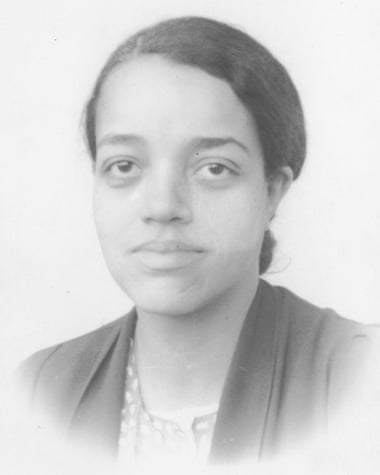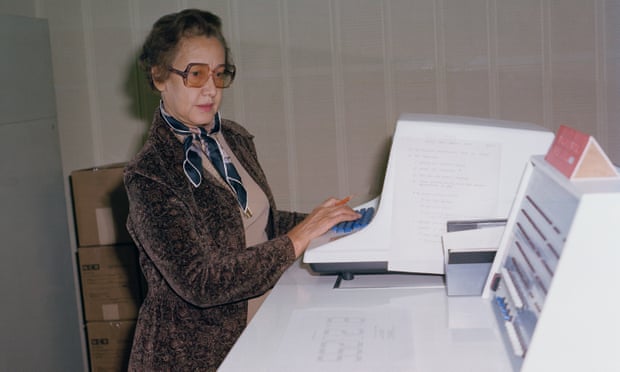You have not posted anything that refutes the story of these women as being the truth.
- Why isn’t Johnson mentioned in John Glenn’s John Glenn: A Memoir or Alan Shepard’s Moon Shot: The Inside Story of America’s Race to the Moon?
- Why does Charles Murray not mention her in his seminal book on the Apollo program (co-authored with Katherine Murray), Apollo: Race to the Moon?
- Why is Johnson not mentioned in Tom Wolfe’s epic The Right Stuff, documenting the sensational story of NASA’s first astronaut group, the all-white Mercury 7.
- Why, especially oddly, is Johnson not mentioned in We Could Not Fail: The First African Americans in the Space Program.
- Why was Johnson not mentioned in either Jet or Ebonymagazine, two black magazines that spent the 1960s and 1970s simultaneously lamenting the lack of blacks at NASA and celebrating any minor achievements of blacks in the space program.
(Finally, she appeared May 23, 2005 issue of
Jet:
A physicist, space scientist, and mathematician, Katherine Johnson gained a minute in the national glare in 1970 when she was instrumental in formulating calculations that helped the crippled Apollo 13 return home safely.
U.S. Rep. Eddie B. Johnson Pushes Resolution To Support Black Women In Science & Technology
Curiously, the
Jet article acknowledges “very little literature documents African American women and their place in science”).
- Why, given her alleged role in the Apollo 13 drama, does Johnson not appear in Jim Lovell’s autobiographical Lost Moon: The Perilous Voyage of Apollo 13 (subsequently made into the Tom Hanks movie, Apollo 13).
- Why does Gene Kranz, the Flight Director of NASA famously played by Ed Harris in Apollo 13, fail to mention Katherine Johnson in his autobiography Failure is Not an Option: Mission Control from Mercury to Apollo 13 and Beyond?
- Why, perhaps most significantly, does Johnson not appear in Harlem Princess: The Story of Harry Delaney’s Daughter, the autobiography of Ruth Bates Harris? Harris, who took the job of Deputy Assistant Administrator for Equal opportunity for NASA in 1972, famously said, “I saw no minorities or women as astronauts. Could I help make a difference?” Harris waged a war to get more blacks involved with NASA, which was a paltry 5.6 percent non-white in 1973 versus a government agency average of 20 percent minority. [Societal Impact of Spaceflight, 2007, PDF]
- Why does Johnson not appear in Beyond Uhura: Star Trek and Other Memories, by the black actress Nichelle Nichols, who played the part of Lt. Uhura in the iconic TV series Star Trek? Nichols waged a personal crusade against the overwhelming white nature of NASA, giving a speech in 1977, “New Opportunities for the Humanization of Space,”lamenting how white the space agency was and how this was dehumanizing to nonwhites.
Many leading white liberals in the 1960s wanted to find a way to put a black into space. Edward R. Murrow wrote a
letter to
James E. Webb, then the Administrator of NASA reading thus:
September 21, 1961
Dear Jim,
Why don’t we put the first non-white man in space?
If your boys were to enroll and train a qualified Negro and then fly him in whatever vehicle is available, we could retell our whole space effort to the whole non-white world, which is most of it.
As ever,
Yours,
Edward R. Murrow
Just last year, after Katherine Johnson was awarded the Medal Of Freedom by President Obama, she named “West Virginian of the Year” and these strange words were written about her:
Johnson’s achievements, despite their significance, went largely unnoticed.
“No one knows that John Glenn wouldn’t fly unless Katherine Johnson checked the math,” Megan Smith, the White House chief technology officer,
said in October. “It’s an amazing story, and it’s totally unknown.”
Johnson was never mentioned in the New York Times or the Washington Post before this year. She is nowhere to be found in ‘This New Ocean,’ NASA’s comprehensive internal history of Project Mercury.
Before 2015, the Charleston Gazette and Daily Mail wrote about her exactly once. The story appeared in the Gazette in 1977 to note that she had been honored by the Afro-American Historical and Cultural Museum in Philadelphia. It did not mention NASA. It was five sentences long.
“We’re in a country that sometimes we have revisionist history, and if you go look at history books, lots of times there aren’t African-Americans in there,” said Leland Melvin, a former space shuttle astronaut. “It’s so easy to just have an omission and play up the people and things that you want to make prominent.”
During the Mercury and Apollo missions, that meant playing up the stereotype of the first seven astronauts.
“Back then, you were a test pilot with a crew cut,” Melvin said. “The original seven,
Life Magazine with the wives and the Corvettes — there wasn’t room for anyone else in that dialogue.”
[
West Virginian of the Year: Katherine G. Johnson, Charleston Gazette Mail, by David Gutman, December 26, 2015. Link in original].
Let’s be honest: the only “revisionist” history going on right now is the push to have Americans in 2016 believe a black woman was key to NASA’s
putting a man on the moon.
Minority Occupied America may not put men on the moon. But it can hype
Politically Correct myths,
http://www.vdare.com/articles/hyped-figures-john-glenn-and-the-pc-myth-of-katherine-johnson-unsung-black-women-were-not-what-got-us-1to-the-moon





 you are so silly!
you are so silly!



